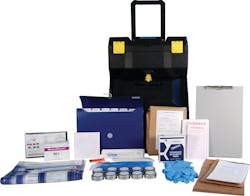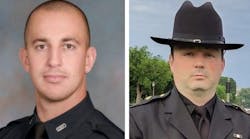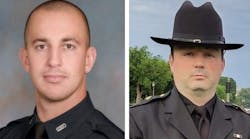In North Carolina, a new chief medical examiner has brought a renewed emphasis on child death investigation training.
That doesn't mean North Carolina wasn't been doing good things in the area of child death investigation before 2010, when Dr. Deborah Radisch replaced Dr. John D. Butts Jr., who served as the state's chief medical examiner for 23 years.
In 2000, the North Carolina Office of Chief Medical Examiner added the position of child death scene investigator/trainer. Lisa Mayhew has held the position since then and trains law enforcement officers, whom the chief medical examiner's office relies upon. (North Carolina doesn't have local death investigators who go to death scenes.)
When she first started, Mayhew says the state didn't have standard operating procedures specific to child deaths, so she and others in the NC Child Fatality Prevention Program developed materials to cover the basics. Mayhew's book "Child Death Investigations: Interdisciplinary Techniques from Cradle to Court" was published in 2007.
Early on, she says she found the biggest problem was law enforcement investigations were lacking key critical details.
"If you have a death and no one knows how that death occurred, then a thorough investigation needs to be conducted, whether the victim is 2 weeks old or 80 years old," she says.
Today, Mayhew reports the medical examiner's office is getting the more detailed information it needs. That's especially important with infant deaths, which Mayhew says make up almost half of the approximately 600 child cases reported to the Medical Examiner System for medicolegal investigation.
Each year in the United States, more than 4,500 infants die suddenly of no immediately, obvious cause, according to statics from the CDC.
Autopsies will not reveal all the answers, as the American Academy of Pediatrics states, "It is impossible to distinguish at autopsy between SIDS and accidental or deliberate asphyxiation with a soft object," "Distinguishing Sudden Infant Death Syndrome From Child Abuse Fatalities," PEDIATRICS Vol. 107 No. 2 February 2001, pp. 437-441.
Medical examiners, pathologists rely on law enforcement to bring them good, detailed information about what a scene has indicated and what various caregivers and/or witnesses say to help medical examiners properly interpret what they see at the autopsy table.
Dr. Tracey Corey, the Chief Medical Examiner for the State of Kentucky, says, "The practice of medicine involves taking a history and physical. Since our patients can't give us that history, we rely on law enforcement."
Death investigators — and patrol officers, the first to arrive at a child death scene — need to have a basic understanding of the unique nature of pediatric cases. Because sudden, unexplained child deaths are not as common as other experiences law enforcement has on the job, law enforcement must rely on good training and good tools.
Child vs. adult homicide investigations
To understand child death investigations means understanding everything that's known about adult death investigation can't just be applied to children, Corey says.
Corey is a consultant to the FBI National Center for the Analysis of Violent Crime within the Child Abduction Serial Killer Program, and serves on the Research Advisory Board thereof. As an instructor for the Public Agency Training Council (PATC), Corey teaches a separate section on pediatrics when she talks to law enforcement officers about death investigation.
"Children get different natural diseases than we do," she says. "They die from different natural diseases than we do and they can respond differently to trauma than adults do. You have to always consider that children are not just little versions of us. Their causes of accidental death are different than ours. We're looking for different risk factors and hazards unique to the pediatric age group."
As a homicide detective with a Ph.D. in human behavior, Thomas Streed was loaned out by the San Diego County Sheriff's Department to agencies throughout the country during his 24-year career. During this time he was involved in more than 2,000 death investigations.
Generally speaking, Streed says it's more difficult to get information from people in child death investigations than it is in other cases. If there's a bar fight or road-rage incident, or another one-on-one incident involving adults, everyone wants to tell their side of the story, Streed says, but that's not usually the case when a child dies.
He says it's also difficult to find valuable DNA, fingerprint or trace evidence because these things naturally will be found at the scene.
Child death scenes will often be more contaminated than others because caregivers call for help, and people, who are legitimately concerned, enter the scene, trying to help, he adds.
"It's a nightmare of an investigation compared to a typical circumstance where someone commits a robbery and shoots the clerk -- no one wants to go near that crime scene," Streed says.
Wisconsin Department of Justice, Division of Criminal Investigation (DOJ-DCI) Special Agent James Holmes coordinates the WI DOJ-DCI's Annual Two-Week Death Investigation School. The school includes a block on child fatality investigations and a day on crime scenes, which includes crib deaths.
Holmes, the Northern Regional Director on the Board of Directors for the International Homicide Investigator's Association, teaches investigators to "think dirty" in death investigations.
"I always say treat an infant death like you would treat a 24-year-old female who was stabbed to death," he says. "Treat every child death like a homicide until proven otherwise. A lot of times, babies found deceased don't have outward signs of injury. Until an autopsy is done, you don't know what happened. If you treat every baby death like it could be a homicide, you're going to limit your mistakes. You're going to do detailed interviews, you're going to do great scene investigation by taking a lot of photos. And you're going to have an autopsy done."
Holmes organizes child death investigations into four parts:
1) Caregiver interviews: Determine the history of the child in the past 72 hours minimum. Holmes notes if the child's death is a homicide, chances are good the person who did it is one of the people you're talking to at the crime scene.
2) Scene investigation: Conduct a thorough investigation to include asking the person who placed an infant in a crib to show you how she or he did so using a doll. Ask the person who found the child to show how the child was found. Take photographs and video.
3) A forensic autopsy: Request a forensic autopsy.
4) Medical history: Obtain all medical records associated with the child. This will allow investigators to learn what kind of injuries has the child has had in the past. If investigators are seeing old injuries and they're not seeing the caregiver take the child for a checkup, Holmes says that's a concern. Also, how did caregivers act when they interacted with medical staff?
Start interviews at the beginning
The initial responder has the responsibility of freezing the crime scene and extracting very basic information during an interview, which Streed says should not be an interrogation.
Streed has found most investigators tend to want to start in the middle, with what happened, and go from both directions.
"That's wrong because it gets confusing and it's easy to overlook things," he says.
In the Interviewing Psychology module of the CDC's student guide for the "Sudden, Unexplained Infant Death Investigation Specialist," published in 2005, Streed talks about an efficient template for imposing guidance and structure on an interview. The "Three Es" include: the entry phase, the event phase and the escape phase.
Streed explains: "You start the investigation with trying to determine how all the players got together, how the witnesses came in contact with the victim, and the victim and witnesses came in contact with the suspects. It's the collision course that everybody's on. The second part is the event – what happened when everybody got together. That's how the fatal blow was struck. That's how witnesses happened to see what they saw. The third part is what they did afterwards. Did they try to conceal evidence? Did they try to orchestrate an alibi? Did they try to blame someone else? Those kinds of things."
Innocent people do not try to orchestrate an alibi, he adds.
"Innocent parents whose youngsters have suddenly died want to tell you everything they can possibly think of because they want you to figure out what, why it happened and how it happened," he says.
Lt. Clay Jansson of the Oakland County Sheriff's Office in Michigan and a child death scene expert, emphasizes, "A death investigation needs to be thorough. You cannot assume a death is simply an 'accident.' It is the obligation and duty of law enforcement to provide thorough and accurate scene information to our pathologists. We sometimes have to ask uncomfortable, hard-hitting questions.'"
Jansson says officers may be afraid to ask some of those questions because caregivers have been through a lot with the death of a child.
He responds to this type of thinking by saying: "Nothing we can do is going to be any worse than them losing their child. They've hit the most traumatic spot in their life. Our goal is to get those answers not only for ourselves, but for the parents so if the cause of death is accidental and they have another child, they don't make some of those same mistakes."
Jansson has conducted training for PATC, the Michigan Public Health Institute, the National District Attorney's Association, Oakland Community College, the State of Nevada-Department of Human Services, and the State of Louisiana.
To prepare for these interviews, Streed says law enforcement should learn to interpret the responses they might encounter from grieving caregivers.
Tools and training
To make sure investigators don't forget something and to help ensure an investigation is properly done, many law enforcement officers use checklists.
The CDC has one. States sometimes have their own.
Tri-Tech Forensics Inc. in November 2010 came out with detailed Infant/Child Death Investigation Kit with forms and instructions to assist law enforcement and medicolegal investigators. The kit includes customized information specific to the common types of deaths of infants and minors, as well as the necessary authorization for release of information and demographic forms so that relevant records can be obtained.
Although Holmes uses checklists, he clarifies that doesn't mean if a checklist wasn't used, an investigation was improperly done.
A checklist is nothing more than boxes investigators check to make sure they've asked all the questions, Streed says. If there's a question that is not relevant, he says, "you indicate that and go on."
Corey advocates checklists. Since child death investigations are relatively rare, she says it helps to have a checklist to remind investigators of the things that make child death investigations unique.
After working countless child death cases Jansson continues to use a checklist.
North Carolina created its own, shorter checklist based on questions that medical examiners weren't regularly getting answers to and in stopped using it in 2010, after the attorney general said the information must be made public.
"We could no longer protect that information," Mayhew says.
She adds that checklists aided medical examiners tremendously, and she includes information from the checklist in her training programs.
Child death investigation (who should be called and initial scene investigation) is taught in North Carolina's Basic Law Enforcement Training, and a module is being created as an option for the 4 hours of in-service training law enforcement officers are required to have each year. Those are in addition to the two-day child death investigation training Mayhew does for local and state agencies 20 to 24 times a year by request, and through the North Carolina Justice Academy. Mayhew also offers training outside of North Carolina through Tri-Tech Forensics. Scene reconstruction is part of that training and encouraged especially when the child who died is under 1 year old.
Caregivers show how they put the baby down, how they found the baby. Medical examiners can then look at pictures and video of the reconstruction when they do an autopsy.
"It's made a huge difference in our ability to distinguish what could be a natural death and what could be accidental," she says.
She encourages officers to do reconstructions as soon as possible.
If the investigators approach is right, she says they should get full cooperation.
"If an investigator's approach is disrespectful or insensitive, they're probably not going to get the caregiver to do the reconstruction, "says Mayhew. "I've never heard of anyone refusing to do a reconstruction. Parents want to know how their child has died. If they think this is the way to find that out, they'll do it. It's all in how it's handled – and that should be with respect and sensitivity."
After a thorough case investigation, the CDC says many sudden unexpected infant deaths may be explained. Poisoning, metabolic disorders, hyper or hypothermia, neglect and homicide, and suffocation are all explainable causes of SUID. The CDC points out even when a thorough investigation is conducted, it may be difficult to separate SIDS from other types of sudden unexpected infant deaths, especially accidental suffocation in bed.
It is also possible that after a thorough investigation and a forensic autopsy, the cause of death may be unknown.
If in fact the cause of death is undetermined, Radisch encourages medical examiners to list the cause of death as just that "undetermined."
In 2007, the North Carolina Office of the Chief Medical Examiner certified the cause and manner of death for 567 of the children. The majority of the deaths were classified as unintentional, accounting for 45 percent; natural deaths accounted for 35 percent; homicides 11 percent; suicides 5 percent; and in 4 percent of deaths (24) the manner in which a child died could not be determined.
"No one knows how a case will turn out at the onset," Mayhew says. "That is what the investigative process is for and why it is so important. Regardless of circumstances, every death should receive attention. I don't care how cliché it may sound, when people die, we are their voice, and they deserve all we can give them. Also, the parents deserve to know how their child died. I personally feel that I work for them as much as I do the state, even though the answers are not always what they want to hear."
Rebecca Kanable is a freelance writer specializing in law enforcement topics. She can be reached at [email protected].
Photo: Tri-Tech Forensics Inc.



